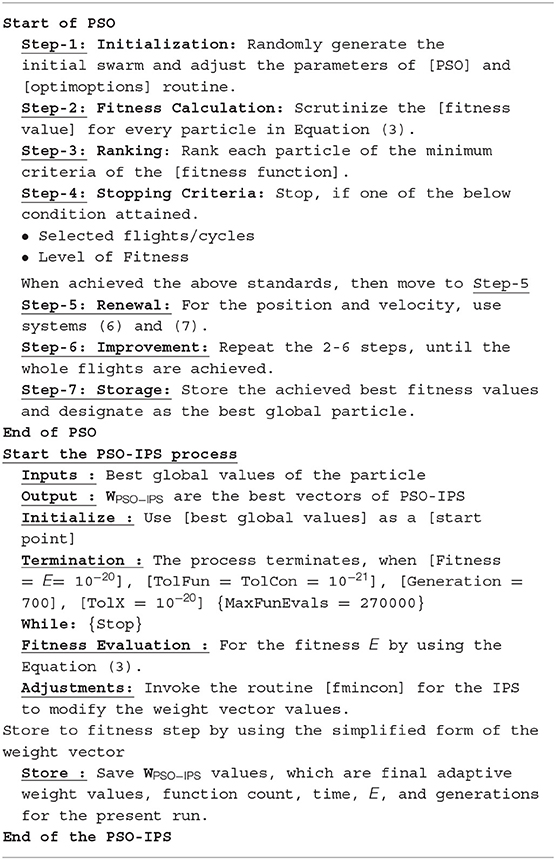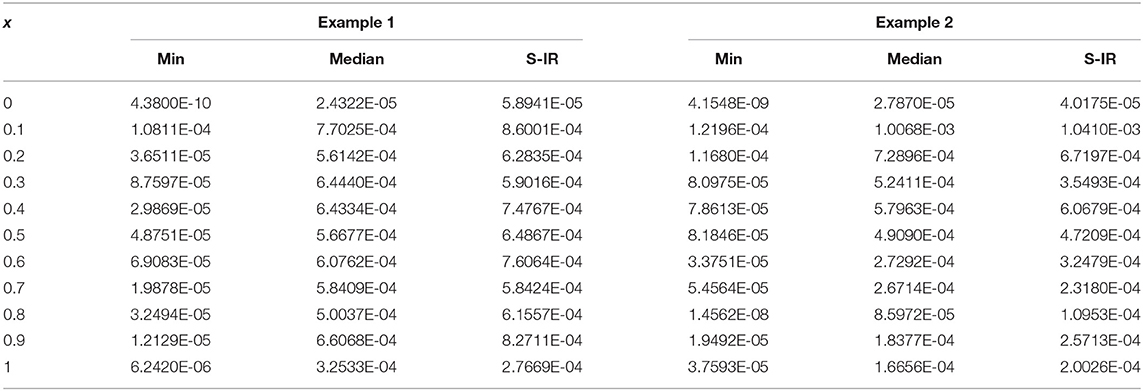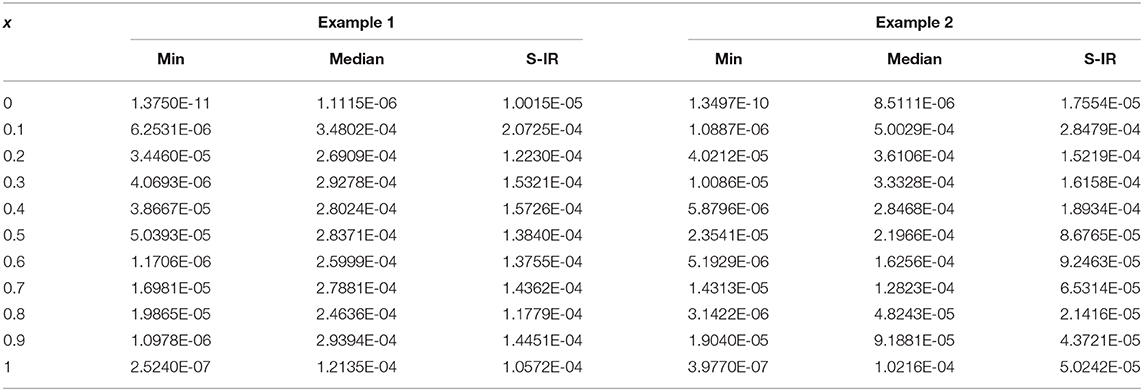A Neuro-Swarming Intelligence-Based Computing for Second Order Singular Periodic Non-linear Boundary Value Problems
- 1Department of Mathematics and Statistics, Hazara University, Mansehra, Pakistan
- 2Future Technology Research Center, National Yunlin University of Science and Technology, Douliu, Taiwan
- 3Department of Electrical and Computer Engineering, COMSATS University Islamabad, Attock, Pakistan
- 4Department of Applied Mathematics and Statistics, Hospital de Marina, Technical University of Cartagena, Cartagena, Spain
- 5Department of Mathematics, COMSATS University Islamabad, Attock, Pakistan
In the present investigation, a novel neuro-swarming intelligence-based numerical computing solver is developed for solving second order non-linear singular periodic (NSP) boundary value problems (BVPs), i.e., NSP-BVPs, using the modeling strength of artificial neural networks (ANN) optimized with global search efficacy of particle swarm optimization (PSO) supported with the methodology of rapid local search by interior-point scheme (IPS), i.e., ANN-PSO-IPS. In order to check the proficiency, robustness, and stability of the designed ANN-PSO-IPS, two numerical problems of the NSP-BVPs have been presented for different numbers of neurons. The outcomes of the proposed ANN-PSO-IPS are compared with the available exact solutions to establish the worth of the solver in terms of accuracy and convergence, which is further endorsed through results of statistical performance metrics based on multiple implementations.
Introduction
The singular differential equations have immense applications in a variety of areas of mathematics and physics, such as dynamics, nuclear physics, chemical reactions and atomic designs etc. The research investigations of non-linear singular periodic boundary value problems (NSP-BVPs) are mainly based on differential equation models. Due to non-linearity, singular points and the periodic nature of the mathematical models, only a few existing analytical and numerical approaches are available in literature to present the solutions of the NSP-BVPs [1–5]. A few problems are provided as Agarwal [6, 7] implemented a well-known numerical shooting approach to solve NSP-BVPs. Geng and Cui [8] presented the individuality and existence for solving the NSP-BVPs. Some other numerical techniques are employed to analyze the significance of the proposed problem NSP-BVPs [9–11]. Assadi et al. [12] exploited a fixed point iterative scheme, Xin et al. [13] a non-trivial solution of NSP-BVPs, El-Syed and Gaagar [14] provided the existence of a solution for non-linear singular differential equations, Wang et al. [15] and Wang and Ru [16] a positive solution of periodic equations. The general form of the second order non-linear NSP-BVPs is written as [8]:
where p(x) and q(x) are continuous, N(Ψ) is a function of Ψ. Moreover, β1, δ1, β2, and δ2 are the positive constant values. All of the above cited analytical/numerical schemes have their precise advantages, disadvantages, merits and demerits, while a stochastic numerical solver based on the intelligent computing approach by manipulating the strength of artificial neural networks (ANNs), particle swarm optimization (PSO), and interior-point scheme, i.e., ANN-PSO-IPS, has not been implemented to solve second order NSP-BVPs.
Researchers have widely studied the meta-heuristic based computing numerical approaches along with the neural network's strength for solving the linear/non-linear mathematical models [17–24]. Some recent applications of heuristic computing are corneal models for eye surgery [25], the non-linear Riccati system [26], the Bagley-Torvik system [27], non-linear systems of Bratu type [17], prey-predator non-linear models [28], non-linear reactive transport models [29], non-linear optics models [30], non-linear singular functional differential models [31], singular non-linear systems arising in atomic physics [32], non-linear doubly singular systems [33], nanofluidic systems [34], micropolar fluid flow [35], the heartbeat model [36], the singular Lane-Emden equation based model [37], the heat conduction model of the human head [38], non-linear electric circuit models [39], finance [40], and mathematical models in Bioinformatics [41, 42]. These influences proved the value, worth and consequence of the stochastic solvers based on robustness, accuracy and convergence.
Keeping in view the value and worth of these applications, the authors worked to exploit the strength and significance of stochastic solvers for a reliable, efficient and stable approach to solve the NSP-BVPs. The present analysis for NSP-BVPs given in Equation (1) is performed via stochastic numerical solver along with utilization of the strength of artificial neural networks (ANNs) based on certain numbers of neurons, particle swarm optimization (PSO) and interior-point scheme, i.e., ANN-PSO-IPS. Some innovative influences of the presented solver are briefly summarized as:
• Novel neuro-swarm intelligent/soft computing heuristics ANN-PSO-IPS using different number of neurons are accessible for the numerical behavior of the second order NSP-BVPs.
• The overlapping outcomes of the designed ANN-PSO-IPS with the referenced exact solutions for two different variants of the second order non-linear NSP-BVPs establish the convergence, correctness and reliability.
• Authorization of accurate performance is validated through statistical observations on multiple runs of ANN-PSO-IPS in terms of Theil's Inequality Coefficient (TIC), Variance Account For (VAF), and semi-interquartile range (S-IR) and Nash Sutcliffe Efficiency (NSE) metrics.
• Besides practically accurate continuous outcomes on input training interval, ease in the concept, the smooth implementable procedure, robustness, extendibility, and stability are other worthy declarations for the proposed neuro-swarm intelligent computing heuristics.
The remaining parts of the paper are planned as: section Design Methodology defines the explanation of the proposed methodology for ANN-PSO-IPS, mathematical forms of the statistic based operators are provided in section Statistical Measures, the detailed results and discussions are given in section Results and Discussion, while the conclusions and future research plans are provided in section Conclusions.
Design Methodology
The design approach of ANN-PSO-IPS is divided into two categories for a numerical solution of the non-linear second order NSP-BVPs. In category 1, the error-based fitness function is introduced, while in the second category, the combination of an optimization scheme PSO with IPS, i.e., PSO-IPS, is provided in the sense of introductory material, applications, and pseudocode.
ANN Modeling
Mathematical models for non-linear second order NSP-BVPs are assembled with the feed-forward ANNs strength, shows the continuous mapping results, and its derivatives using the log-sigmoid U(x) = (1+exp(−x))−1 activation functions given as:
where the weights are a = [a1, a2, a3, ..., am], w = [w1, w2, w3, ..., wm] and b = [b1, b2, b3, ..., bm]. In order to solve the non-linear second order NSP-BVPs given in the system (1), an error-based fitness formulation using the mean square error sense is written as:
where E1 and E2 are the error functions related to the differential system and the boundary conditions, respectively, written as:
where , while is the approximate solution of Ψ of system represented in (1), N is total number of input grid points and h is the step size.
Optimization Process: PSO-IPS
The parameter optimization for second order non-linear NSP-BVPs is approved by the hybrid computing framework based on PSO and IPS.
The PSO approach [43] is applied as an effective alternative to the efficient global search mechanism of genetic algorithms [44] that is used as an optimization apparatus for the second order non-linear NSP-BVPs. Kennedy and Eberhart proposed PSO, which is a famous algorithm for the global search optimization strength, at the end of the 19th century. PSO is considered as an easy implementation process with low memory requirements [45]. This optimization algorithm exploits mathematical modeling inspired bythe swarm pattern of birds flocking as well as fish schooling. Recently, this global optimization procedure is used in different applications, like the fuel ignition model [46], non-linear physical models [47], parameter approximation systems of control auto regressive moving average models [48], balancing stochastic U-lines problems [49], operation scheduling of microgrids [50], and features classification [51].
In the search space theory, a single candidate solution is called a particle using the optimization process. For the PSO optimization approach, the prime swarms spread into the larger and for the adjustment of the parameters of PSO, the scheme delivers iteratively optimal outcomes and that indicate the swarm's position and velocity. The mathematical form is given as:
where the position and velocity are Xi and Vi, respectively, r1 and r2 are the pseudo random vectors between 0 and 1, while δ1 and δ2 are the acceleration constant values. The inertia weight vector is ω∈[0, 1]. The scheme performance stops when the predefined flights are obtained.
The dynamic of the optimization PSO rapidly converges by the hybridization process with the suitable local search scheme by taking PSO global best values as an initial weight. Therefore, an efficient local search approach based on interior-point scheme (IPS) is used for quick fine-tuning of the outcomes achieved by the designed optimization approach. Some recent submissions of the IPS are mixed complementarity monotone systems [52], active noise control systems [53], simulation of aircraft parts riveting [54], the economic load dispatch model [55], and non-linear system identification [56].
The pseudocode based on the combination of PSO-IPS trains the ANN as well as the crucial setting of the parameters for both PSO and IPS are provided in Table 1. The optimization method become premature using a minor change in the parameter setting, thus, it requires several experiences, replications and information on essential optimization impressions of appropriate settings for the hybrid of PSO-IPS.
Statistical Measures
The present study aims to present the statistical performance for solving both variants of second order non-linear NSP-BVPs. In this respect, three performance operators are implemented based on Theil's inequality coefficient (TIC), Nash Sutcliffe Efficiency (NSE), and Variance Account For (VAF). The mathematical notations of these operators are given as:
Results and Discussion
In this section, the detailed results based on two variants of the second order NSP-BVPs are presented using the ANN-PSO-IPS and comparison of the proposed outcomes with the exact solutions will also be discussed.
Example 1: Consider the second order SPBVP is written as:
The true solution of the Equation (12) is e10(x−x2)2 and the fitness function is written as:
Example 2: Consider the non-linear second order SPBVP is written as:
The exact solution of the above equation is e10(x−x2)2 and the fitness function is written as:
In order to perform the solutions of the second order NSP-BVPs, the optimization is accomplished using the hybrid of global and local search capabilities, i.e., PSO-IPS. The process is repeated for sixty trials to generate a large dataset parameter using the ANNs. The best weight sets are provided to indicate the approximate numerical outcomes of the model (1) using 5 and 10 numbers of neurons. The mathematical formulations of the proposed numerical outcomes for 5 neurons are shown as:
The mathematical formulations of the proposed numerical outcomes for 10 number of neurons are written as:
The optimization of the relations (13) and (15) is carried out with PSO-IPS for sixty trials and one set of trained weight of ANN based on 5 and 10 neurons is plotted in the Figures 1A,B, 2A,B. The comparison of the best, mean and exact solutions are drawn in the Figures 1C,D, 2C,D for 5 and 10 numbers of neurons. The best and mean results obtained by the designed approach ANN-PSO-IPS are overlapped to the exact results for both of the examples. This consistent overlapping of the results indicates the exactness and correctness of the designed scheme. The plots of absolute error (AE) for the 5 and 10 number of neurons are drawn in Figures 1E,F, 2E,F. These AE values have been obtained by using the proposed results obtained by ANN-PSO-IPS and the exact solutions. It is clear in Figures 1E,F that most of the best solutions lie around 10−04−10−05 for both examples, while the mean values lie around 10−02−10−03 and 10−03−10−04 for examples 1 and 2, respectively. The best AE values for 10 neurons are plotted in Figures 2E,F lie around 10−04−10−06, while the mean values lie around 10−03−10−04 for both examples. In order to find the best and mean values of the performance indices based on the VAF, ENSE, and TIC values, the Figures 1G,H, 2G,H have been plotted using the 5 and 10 number of neurons for both examples. The best ENSE, TIC, and EVAF values for 5 neurons lie around 10−06−10−08 for both examples. Whereas, for both examples using 5 numbers of neurons, the best ENSE values lie around 10−02−10−04 and the best TIC and EVAF values lie around 10−04−10−06. Furthermore, for the 10 numbers of neurons, the best values of ENSE, TIC, and EVAF are close to 10−08 for example 1, while for example 2, these best values lie around 10−08−10−09. The mean ENSE and EVAF values for the example 1 and 2 lie around 10−06−10−07, while the mean TIC values lie around 10−07−10−08 for both examples. It is noticed that the results of AE and the performance measures for 10 neurons are found to be better when compared to 5 neurons.
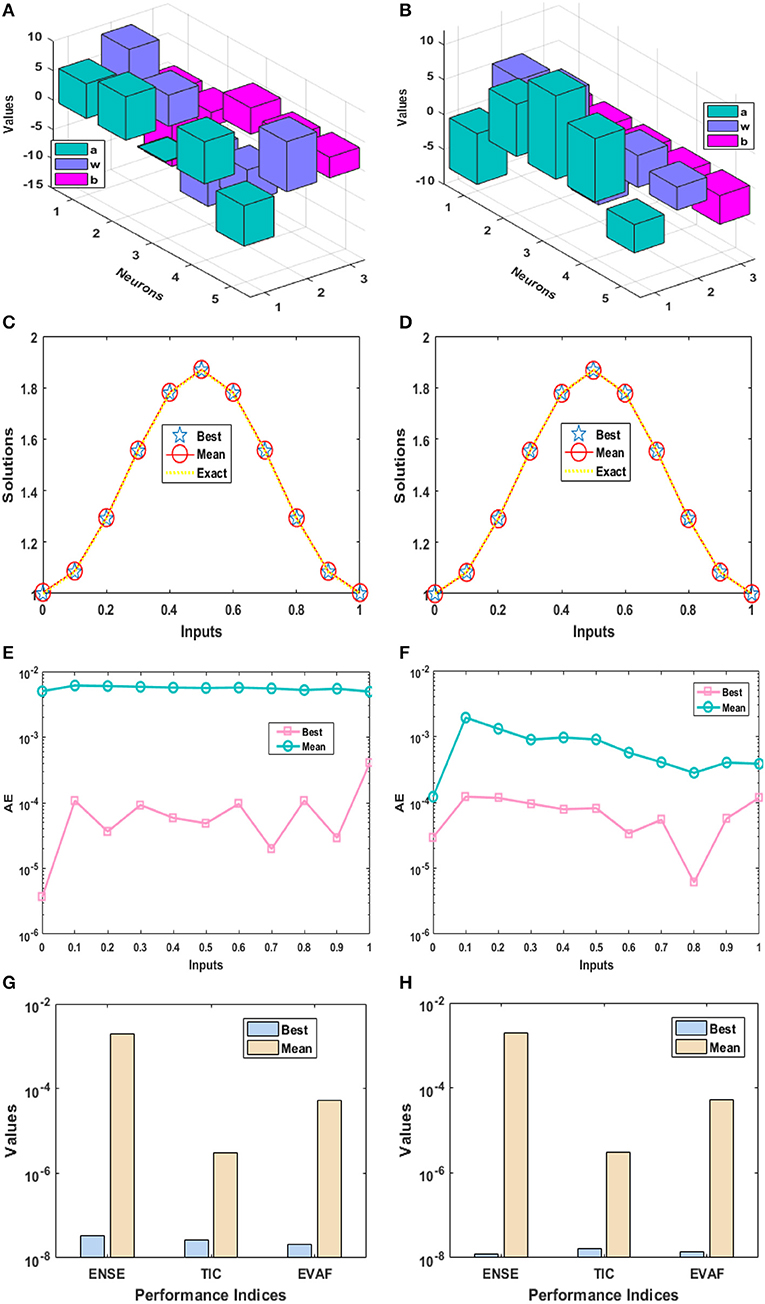
Figure 1. Best weight, results of the designed methodology, values of the AE, and performance measures of Examples 1 and 2 for 5 numbers of neurons. (A) ANN best weights for Example 1. (B) ANN best weights for Example 2. (C) Result comparison for Example 1. (D) Result comparison for Example 2. (E) AE values for Example 1. (F) AE values of for Example 2. (G) Performance measures for Example 1. (H) Performance measures for Example 2.
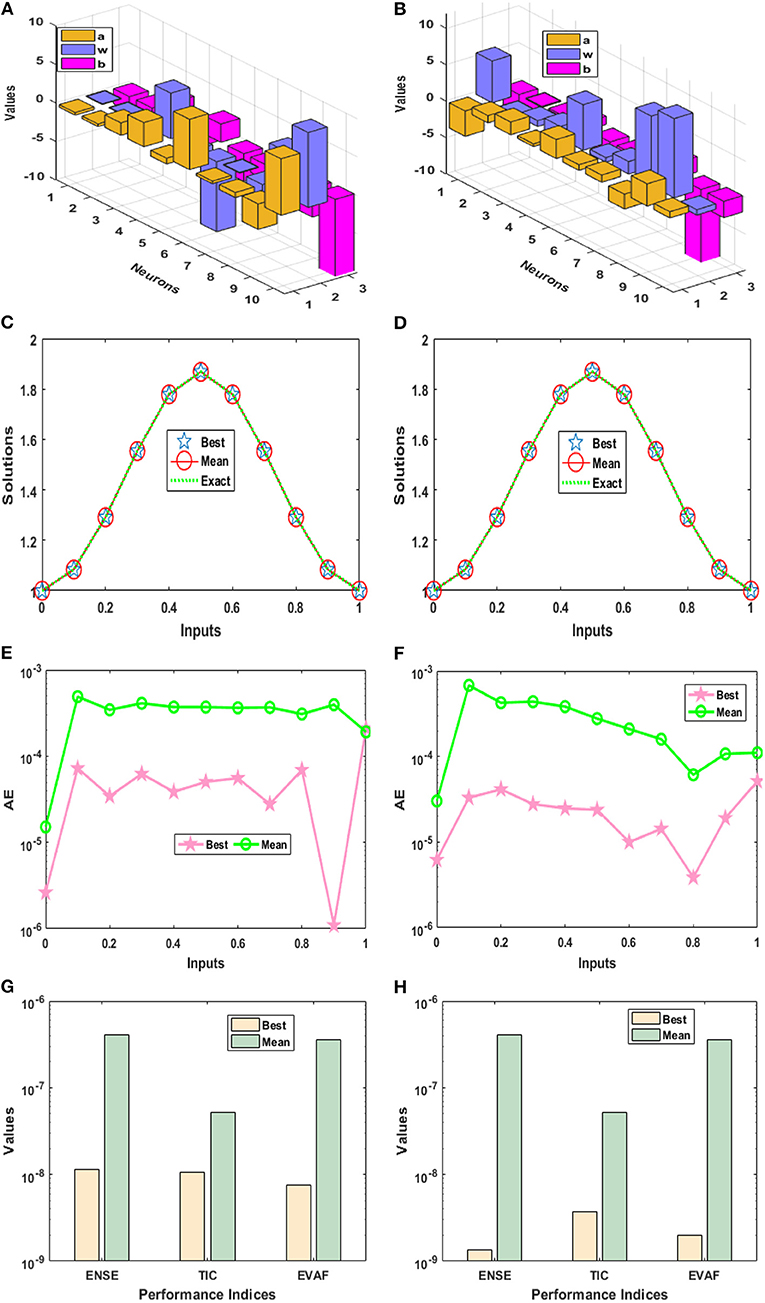
Figure 2. Best weight, results of the designed methodology, values of the AE, and performance measures of Examples 1 and 2 for 10 numbers of neurons. (A) ANN best weights for Example 1. (B) ANN best weights for Example 2. (C) Result comparison for Example 1. (D) Result comparison for Example 2. (E) AE values of 10 neurons for Example 1. (F) AE values of 10 neurons for Example 2. (G) Performance measures for Example 1. (H) Performance measures for Example 2.
Statistical investigations of the present methodology for 60 independent trials using the 5 and 10 numbers of neurons for the examples 1 and 2 are provided in Figures 3, 4. The Fitness, EVAF, ENSE, and TIC values along with the histogram are plotted in Figures 3A,B,G,H. These investigations show that around 70% of independent trials of the designed approach ANN-PSO-IPS achieved higher accuracy for all the statistical performances.
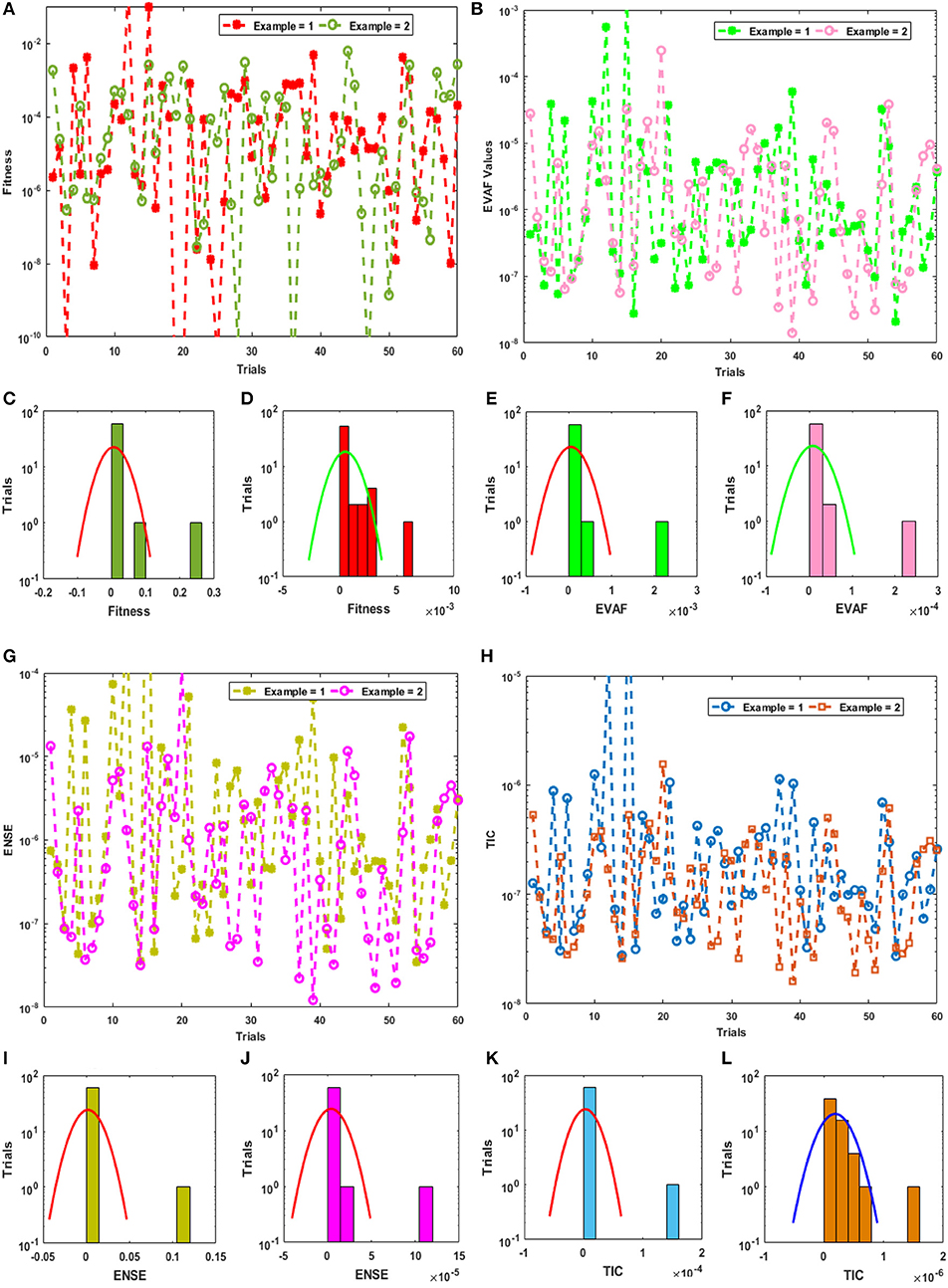
Figure 3. Statistical analysis for Fitness, EVAF, ENSE, and TIC values along with the histograms for 5 numbers of neurons. (A) Analysis through Fitness values. (B) Analysis through EVAF values. (C) Fitness histogram for Example 1. (D) Fitness histogram for Example 2. (E) EVAF histogram for Example 1. (F) EVAF histogram for Example 2. (G) Analysis through ENSE values. (H) Analysis through TIC values. (I) ENSE histogram for Example 1. (J) ENSE histogram for Example 2. (K) TIC histogram for Example 1. (L) TIC histogram for Example 2.
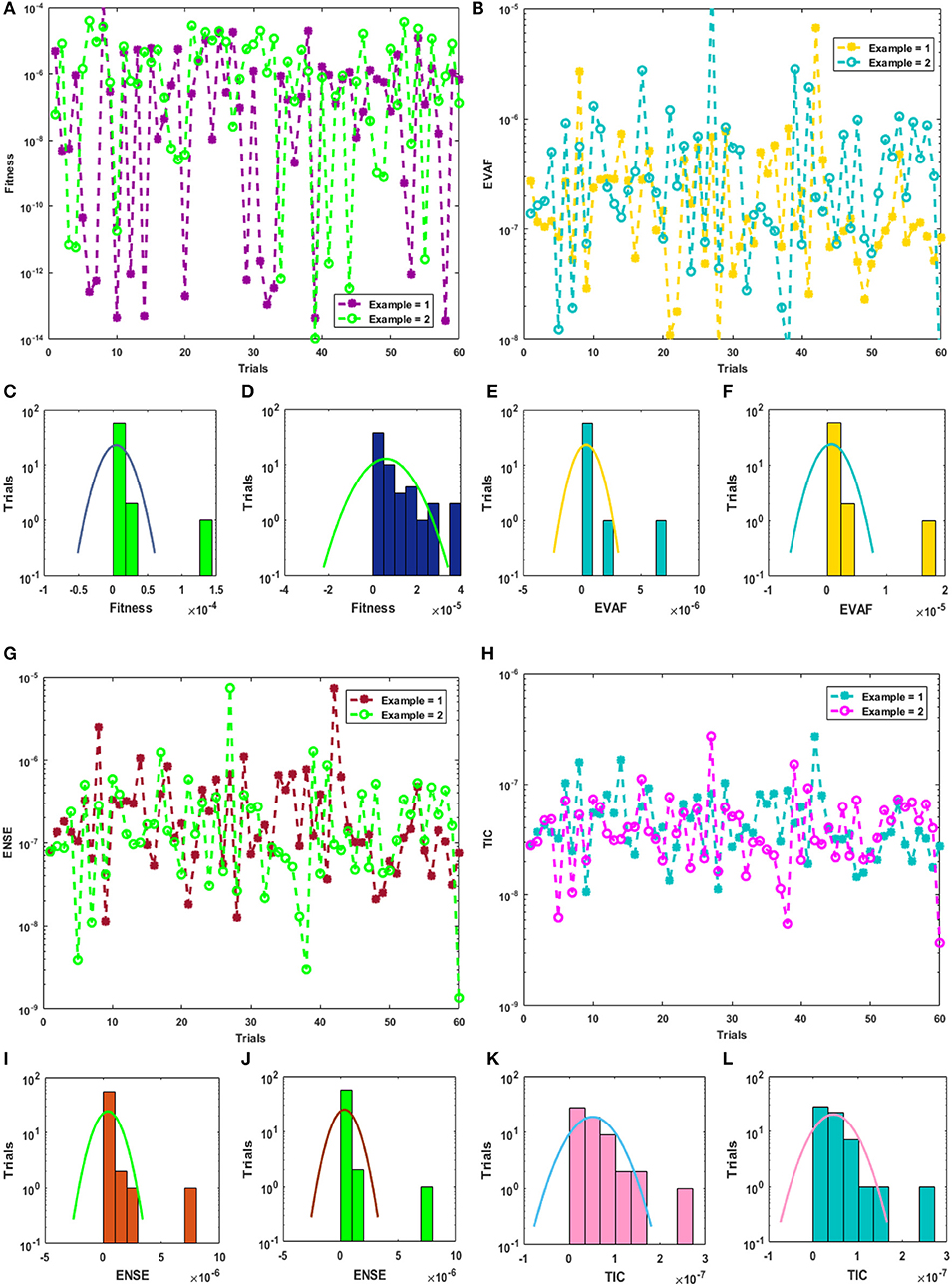
Figure 4. Statistical analysis for Fitness, EVAF, ENSE, and TIC values along with the histograms for 10 numbers of neurons. (A) Analysis through Fitness values. (B) Analysis through EVAF values. (C) Fitness histogram for Example 1. (D) Fitness histogram for Example 2. (E) EVAF histogram for Example 1. (F) EVAF histogram for Example 2. (G) Analysis through ENSE values. (H) Analysis through TIC values. (I) ENSE histogram for Example 1. (J) ENSE histogram for Example 2. (K) TIC histogram for Example 1. (L) TIC histogram for Example 2.
Statistics measures based on Minimum (Min), Median and S-IR gages for solving the second order SPBVP using the 5 and 10 numbers of neurons are tabulated in Tables 2, 3. The statistical measures are provided in order to check the accuracy analysis of the presented scheme ANN-PSO-IPS. In Table 2, the Min values for example 1 and 2 lie around 10−04−10−10 and 10−04−10−09, respectively, while the Median and S-IR values lie around 10−04−10−05 for both examples. In Table 3, the Min values for the examples 1 and 2 lie around 10−05−10−11 and 10−05−10−10, respectively, while the Median and S-IR values lie around 10−04−10−06 for both examples.
Conclusions
A novel application of a stochastic numerical solver based on neuro-swarm intelligent computing is presented to solve the singular non-linear second order periodic boundary value problems using different numbers of neurons based on the neural networks optimized with the global search capability of particle swarm optimization supported with quick fine tuning of decision variables by manipulating the strength of local search via interior-point scheme. The singular periodic model is efficiently evaluated by the designed computing solver with the layer structure based neural networks with 5 and 10 neurons and it is found that the accuracy of numerical outcomes is enhanced by large neurons-based networks. The precision of the stochastic designed approach is verified by obtaining identical outcomes with the exact solutions having 4–6 decimal places of accuracy for solving both the singular periodic non-linear models. From the plots of performance measures using the neuron analysis, one can also conclude that the calculated accuracy is better for 10 numbers of neurons. Statistical interpretation of findings through performance indices of TIC, EVAF, and ENSE based on 60 executions/trials of the solver for obtaining the solution of singular periodic non-linear model validate the trustworthiness, accurateness and robustness. Moreover, the values of the mean, median and semi interquartile range tabulated in Tables 1, 2 provide the precise and accurate values of the presented scheme ANN-PSO-IPS.
In future, the designed approach is a promising alternate solver to be exploited/explored to investigate the computational fluid dynamics problems, especially thin film flow, wire coating analysis, squeezing flow models, Jeffery Hamel flow, calendaring problems, stretching flow problems, food processing models, and related fields [57–62].
Data Availability Statement
The original contributions presented in the study are included in the article/supplementary materials, further inquiries can be directed to the corresponding author/s.
Author Contributions
All authors listed have made a substantial, direct and intellectual contribution to the work, and approved it for publication.
Funding
This paper has been partially supported by Ministerio de Ciencia, Innovacion y Universidades grant number PGC2018-0971-B-100 and Fundacion Seneca de la Region de Murcia grant number 20783/PI/18.
Conflict of Interest
The authors declare that the research was conducted in the absence of any commercial or financial relationships that could be construed as a potential conflict of interest.
References
1. Li F, Liang Z. Existence of positive periodic solutions to nonlinear second order differential equations. Appl Math Lett. (2005) 18:1256–64. doi: 10.1016/j.aml.2005.02.014
2. Atici FM, Guseinov GS. On the existence of positive solutions for nonlinear differential equations with periodic boundary conditions. J Comp Appl Math. (2001) 132:341–56. doi: 10.1016/S0377-0427(00)00438-6
3. Baslandze SR, Kiguradze IT. On the unique solvability of a periodic boundary value problem for third-order linear differential equations. Differ Equat. (2006) 42:165–71. doi: 10.1134/S0012266106020029
4. Komashynska I, Al-Smadi M, Arqub OA, Momani S. An efficient analytical method for solving singular initial value problems of nonlinear systems. Appl Math Inform Sci. (2016) 10:647–56. doi: 10.18576/amis/100224
5. Al-Smadi M, Arqub OA, Shawagfeh N, Momani S. Numerical investigations for systems of second-order periodic boundary value problems using reproducing kernel method. Appl Math Comput. (2016) 291:137–48. doi: 10.1016/j.amc.2016.06.002
6. Agarwal RP, Filippakis ME, O'Regan D, Papageorgiou NS. Degree theoretic methods in the study of nonlinear periodic problems with nonsmooth potentials. Differ Integral Equ. (2006) 19:279–96.
7. Agarwal RP. On periodic solutions of nonlinear second order differential systems. J Comput Appl Math. (1979) 5:117–23. doi: 10.1016/0771-050X(79)90007-X
8. Geng F, Cui M. Solving singular nonlinear second-order periodic boundary value problems in the reproducing kernel space. Appl Math Comput. (2007) 192:389–98. doi: 10.1016/j.amc.2007.03.016
9. Rachunková I. Existence of two positive solutions of a singular nonlinear periodic boundary value problem. J Comput Appl Math. (2000) 113:27–34. doi: 10.1016/S0377-0427(99)00241-1
10. Jiang D, Chu J, O'Regan D, Agarwal RP. Multiple positive solutions to superlinear periodic boundary value problems with repulsive singular forces. J Math Anal Appl. (2003) 286:563–76. doi: 10.1016/S0022-247X(03)00493-1
11. Zhang Z, Wang J. On existence and multiplicity of positive solutions to periodic boundary value problems for singular nonlinear second order differential equations. J Math Anal Appl. (2003) 281:99–107. doi: 10.1016/S0022-247X(02)00538-3
12. Assadi R, Khuri SA, Sayfy A. Numerical solution of nonlinear second order singular BVPs based on green's functions and fixed-point iterative schemes. Int J Appl Comp Math. (2018) 4:134. doi: 10.1007/s40819-018-0569-8
13. Xin L, Guo Y, Zhao J. Nontrivial solutions of second-order nonlinear boundary value problems. Appl Math E-Notes. (2019) 19:668–74.
14. El-Sayed A, Gaafar FM. Existence of solutions for singular second-order ordinary differential equations with periodic and deviated nonlocal multipoint boundary conditions. J Func Spaces. (2018) 2018:1–11. doi: 10.1155/2018/9726475
15. Wang Y, Li J, Cai Z. Positive solutions of periodic boundary value problems for the second-order differential equation with a parameter. Bound Value Probl. (2017) 2017:1–11. doi: 10.1186/s13661-017-0776-y
16. Wang Y, Ru Y. On positive periodic solutions of second order singular equations. Bound Value Probl. (2018) 2018:114. doi: 10.1186/s13661-018-1036-5
17. Masood Z, Majeed K, Samar R, Raja MAZ. Design of Mexican hat wavelet neural networks for solving bratu type nonlinear systems. Neurocomputing. (2017) 221:1–14. doi: 10.1016/j.neucom.2016.08.079
18. Raja MAZ, Niazi SA, Butt SA. An intelligent computing technique to analyze the vibrational dynamics of rotating electrical machine. Neurocomputing. (2017) 219:280–99. doi: 10.1016/j.neucom.2016.09.032
19. Berg J, Nyström K. A unified deep artificial neural network approach to partial differential equations in complex geometries. Neurocomputing. (2018) 317:28–41. doi: 10.1016/j.neucom.2018.06.056
20. Bukhari AH, Raja MAZ, Sulaiman M, Islam S, Shoaib M, Kumam P. Fractional neuro-sequential ARFIMA-LSTM for financial market forecasting. IEEE Access. (2020) 8:71326–38. doi: 10.1109/ACCESS.2020.2985763
21. Pakdaman M, Ahmadian A, Effati S, Salahshour S, Baleanu D. Solving differential equations of fractional order using an optimization technique based on training artificial neural network. Appl Math Comput. (2017) 293:81–95. doi: 10.1016/j.amc.2016.07.021
22. Raja MAZ, Manzar MA, Shah SM, Chen Y. Integrated intelligence of fractional neural networks and sequential quadratic programming for bagley–torvik systems arising in fluid mechanics. J Comp Nonlinear Dynam. (2020) 15:051003. doi: 10.1115/1.4046496
23. Jafarian A, Nia SM, Golmankhaneh AK, Baleanu D. On artificial neural networks approach with new cost functions. Appl Math Comput. (2018) 339:546–55. doi: 10.1016/j.amc.2018.07.053
24. Bukhari AH, Sulaiman M, Islam S, Shoaib M, Kumam P, Raja MAZ. Neuro-fuzzy modeling and prediction of summer precipitation with application to different meteorological stations. Alex Eng J. (2020) 59:101–16. doi: 10.1016/j.aej.2019.12.011
25. Umar M, Amin F, Wahab HA, Baleanu D. Unsupervised constrained neural network modeling of boundary value corneal model for eye surgery. Appl Soft Comput. (2019) 85:105826. doi: 10.1016/j.asoc.2019.105826
26. Raja MAZ, Manzar MA, Samar R. An efficient computational intelligence approach for solving fractional order Riccati equations using ANN and SQP. Appl Math Model. (2015) 39:3075–93. doi: 10.1016/j.apm.2014.11.024
27. Raja MAZ, Samar R, Manzar MA, Shah SM. Design of unsupervised fractional neural network model optimized with interior point algorithm for solving Bagley–Torvik equation. Math Comput Simul. (2017) 132:139–58. doi: 10.1016/j.matcom.2016.08.002
28. Umar M, Sabir Z, Raja MAZ. Intelligent computing for numerical treatment of nonlinear prey–predator models. Appl Soft Comput. (2019) 80:506–24. doi: 10.1016/j.asoc.2019.04.022
29. Li R, Hu S, Wang Y, Yin M. A local search algorithm with tabu strategy and perturbation mechanism for generalized vertex cover problem. Neural Comp Appl. (2017) 28:1775–85. doi: 10.1007/s00521-015-2172-9
30. Ahmad I, Ahmad S, Awais M, Ahmad SUI, Raja MAZ. Neuro-evolutionary computing paradigm for Painlevé equation-II in nonlinear optics. Eur Phys J Plus. (2018) 133:184. doi: 10.1140/epjp/i2018-12013-3
31. Sabir Z, Wahab HA, Umar M, Erdogan F. Stochastic numerical approach for solving second order nonlinear singular functional differential equation. Appl Math Comput. (2019) 363:124605 doi: 10.1016/j.amc.2019.124605
32. Sabir Z, Manzar MA, Raja MAZ, Sheraz M, Wazwaz AM. Neuro-heuristics for nonlinear singular Thomas-Fermi systems. Appl Soft Comput. (2018) 65:152–69. doi: 10.1016/j.asoc.2018.01.009
33. Raja MAZ, Mehmood J, Sabir Z, Nasab AK, Manzar MA. Numerical solution of doubly singular nonlinear systems using neural networks-based integrated intelligent computing. Neural Comp Appl. (2019) 31:793–812. doi: 10.1007/s00521-017-3110-9
34. Mehmood A, Zameer A, Ling SH, Raja MAZ. Design of neuro-computing paradigms for nonlinear nanofluidic systems of MHD Jeffery–Hamel flow. J Taiw Inst Chem Eng. (2018) 91:57–85. doi: 10.1016/j.jtice.2018.05.046
35. Mehmood A, Afsar K, Zameer A, Awan SE, Raja MAZ. Integrated intelligent computing paradigm for the dynamics of micropolar fluid flow with heat transfer in a permeable walled channel. Appl Soft Comput. (2019) 79:139–62. doi: 10.1016/j.asoc.2019.03.026
36. Raja MAZ, Shah FH, Alaidarous ES, Syam MI. Design of bio-inspired heuristic technique integrated with interior-point algorithm to analyze the dynamics of heartbeat model. Appl Soft Comput. (2017) 52:605–29. doi: 10.1016/j.asoc.2016.10.009
37. Sabir Z, Wahab HA, Umar M, Sakar MG, Raja MAZ. Novel design of Morlet wavelet neural network for solving second order Lane–Emden equation. Math Comput Simul. (2020) 172:1–14. doi: 10.1016/j.matcom.2020.01.005
38. Raja MAZ, Umar M, Sabir Z, Khan JA, Baleanu D. A new stochastic computing paradigm for the dynamics of nonlinear singular heat conduction model of the human head. Eur Phys J Plus. (2018) 133:364. doi: 10.1140/epjp/i2018-12153-4
39. Mehmood A, Zameer A, Ling SH, ur Rehman A, Raja MAZ. Integrated computational intelligent paradigm for nonlinear electric circuit models using neural networks, genetic algorithms and sequential quadratic programming. Neural Comp Appl. (2019) 32:10337–57. doi: 10.1007/s00521-019-04573-3
40. Ara A, Khan NA, Razzaq OA, Hameed T, Raja MAZ. Wavelets optimization method for evaluation of fractional partial differential equations: an application to financial modelling. Adv Differ Equ. (2018) 2018:8. doi: 10.1186/s13662-017-1461-2
41. Raja MAZ, Shah FH, Syam MI. Intelligent computing approach to solve the nonlinear Van der Pol system for heartbeat model. Neural Comp Appl. (2018) 30:3651–75. doi: 10.1007/s00521-017-2949-0
42. Raja MAZ, Asma K, Aslam MS. Bio-inspired computational heuristics to study models of hiv infection of CD4+ T-cell. Int J Biomath. (2018) 11:1850019. doi: 10.1142/S1793524518500195
43. Shi Y, Eberhart RC. Empirical study of particle swarm optimization. In: Proceedings of the 1999. Congress on Evolutionary Computation-CEC99. Vol. 3. IEEE (1999). p. 1945–50.
44. Shi Y. Particle swarm optimization: developments, applications and resources. In: Proceedings of the 2001 Congress on Evolutionary Computation. Vol. 1. IEEE (2001). p. 81–6.
46. Raja MAZ. Solution of the one-dimensional Bratu equation arising in the fuel ignition model using ANN optimised with PSO and SQP. Conn Sci. (2014) 26:195–214. doi: 10.1080/09540091.2014.907555
47. Raja MAZ, Zameer A, Kiani AK, Shehzad A, Khan MAR. Nature-inspired computational intelligence integration with Nelder–Mead method to solve nonlinear benchmark models. Neural Comp Appl. (2018) 29:1169–93. doi: 10.1007/s00521-016-2523-1
48. Mehmood A, Zameer A, Raja MAZ, Bibi R, Chaudhary NI, Aslam MS. Nature-inspired heuristic paradigms for parameter estimation of control autoregressive moving average systems. Neural Comp Appl. (2019) 31:5819–42. doi: 10.1007/s00521-018-3406-4
49. Aydogan EK, Delice Y, Özcan U, Gencer C, Bali Ö. Balancing stochastic U-lines using particle swarm optimization. J Intell Manuf. (2019) 30:97–111. doi: 10.1007/s10845-016-1234-x
50. Takano H, Asano H, Gupta N. Application example of particle swarm optimization on operation scheduling of microgrids. In: Frontier Applications of Nature Inspired Computation. Springer (2020). p. 215–39. doi: 10.1007/978-981-15-2133-1
51. Ibrahim RA, Ewees AA, Oliva D, Elaziz MA, Lu S. Improved salp swarm algorithm based on particle swarm optimization for feature selection. J Ambient Intell Humaniz Comput. (2019) 10:3155–69. doi: 10.1007/s12652-018-1031-9
52. Sicre MR, Svaiter BF. A O(1/k3/2) hybrid proximal extragradient primal–dual interior point method for nonlinear monotone mixed complementarity problems. Comp Appl Math. (2018) 37:1847–76. doi: 10.1007/s40314-017-0425-1
53. Raja MAZ, Aslam MS, Chaudhary NI, Khan WU. Bio-inspired heuristics hybrid with interior-point method for active noise control systems without identification of secondary path. Front Inform Tech Electr Eng. (2018) 19:246–59. doi: 10.1631/FITEE.1601028
54. Stefanova M, Yakunin S, Petukhova M, Lupuleac S, Kokkolaras M. An interior-point method-based solver for simulation of aircraft parts riveting. Eng Optimiz. (2018) 50:781–96. doi: 10.1080/0305215X.2017.1355367
55. Raja MAZ, Ahmed U, Zameer A, Kiani AK, Chaudhary NI. Bio-inspired heuristics hybrid with sequential quadratic programming and interior-point methods for reliable treatment of economic load dispatch problem. Neural Comp Appl. (2019) 31:447–75. doi: 10.1007/s00521-017-3019-3
56. Umenberger J, Manchester IR. Specialized interior-point algorithm for stable nonlinear system identification. IEEE Trans Automat Contr. (2018) 64:2442–56. doi: 10.1109/TAC.2018.2867358
57. de Assis RA, Pazim R, Malavazi MC, Petry PDC, de Assis LME, Venturino E. A mathematical model to describe the herd behaviour considering group defense. Appl Math Nonlinear Sci. (2020) 5:11–24. doi: 10.2478/amns.2020.1.00002
58. Li T, Yang W. Solution to chance constrained programming problem in swap trailer transport organisation based on improved simulated annealing algorithm. Appl Math Nonlinear Sci. (2020) 5:47–54. doi: 10.2478/amns.2020.1.00005
59. El-Borhamy M, Mosalam N. On the existence of periodic solution and the transition to chaos of Rayleigh-Duffing equation with application of gyro dynamic. Appl Math Nonlinear Sci. (2020) 5:93–108. doi: 10.2478/amns.2020.1.00010
60. Evirgen F, Uçar S, Özdemir N. System analysis of HIV infection model with CD4+ T under non-singular kernel derivative. Appl Math Nonlinear Sci. (2020) 5:139–46. doi: 10.2478/amns.2020.1.00013
61. Modanli M, Akgül A. On solutions of fractional order telegraph partial differential equation by crank-nicholson finite difference method. Appl Math Nonlinear Sci. (2020) 5:163–70. doi: 10.2478/amns.2020.1.00015
Keywords: singular periodic systems, particle swarm optimization, hybrid approach, interior-point scheme, artificial neural networks, statistical analysis
Citation: Sabir Z, Raja MAZ, Guirao JLG and Shoaib M (2020) A Neuro-Swarming Intelligence-Based Computing for Second Order Singular Periodic Non-linear Boundary Value Problems. Front. Phys. 8:224. doi: 10.3389/fphy.2020.00224
Received: 21 April 2020; Accepted: 25 May 2020;
Published: 07 August 2020.
Edited by:
Shaohui Wang, Louisiana College, United StatesReviewed by:
Yolanda Guerrero-Sánchez, University of Murcia, SpainChaudry Masood Khalique, North-West University, South Africa
Copyright © 2020 Sabir, Raja, Guirao and Shoaib. This is an open-access article distributed under the terms of the Creative Commons Attribution License (CC BY). The use, distribution or reproduction in other forums is permitted, provided the original author(s) and the copyright owner(s) are credited and that the original publication in this journal is cited, in accordance with accepted academic practice. No use, distribution or reproduction is permitted which does not comply with these terms.
*Correspondence: Juan L. G. Guirao, juan.garcia@upct.es
 Zulqurnain Sabir
Zulqurnain Sabir Muhammad Asif Zahoor Raja
Muhammad Asif Zahoor Raja Juan L. G. Guirao
Juan L. G. Guirao Muhammad Shoaib
Muhammad Shoaib